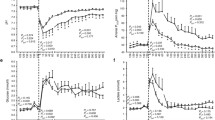Abstract
Dynamic respiratory system compliance (Cdyn) was measured in 44 preterm babies before, immediately after, and for 96 h following administration of artificial surfactant (Exosurf). There was no significant change in Cdyn for the whole group over the entire study period. Subdivision into three groups on the basis of Cdyn prior to surfactant revealed a significant and sustained deterioration in lung function in those babies with the highest starting compliance and a significant and sustained improvement in those with the lowest compliance. Inspired oxygen and alveolar/arterial oxygen gradient also exhibited significant differences with least improvement in the babies with the best initial lung function and most improvement in the babies with worst initial lung function. Despite clear initial differences in clinical status, neither long-term oxygen requirements nor the incidence of chronic lung disease differed significantly between the three groups. We conclude that the response of an individual baby to the administration of surfactant is, in part, determined by the lung function before surfactant is administered. Babies with higher initial lung compliance are more likely to deteriorate after administration and caution should be used before selection of such babies for surfactant treatment.
Similar content being viewed by others
Abbreviations
- AaDO 2 :
-
alveolar arterial oxygen gradient
- Cdyn :
-
dynamic compliance
- FIO 2 :
-
fractional inspired oxygen
- FRC :
-
functional residual capacity
- MAP :
-
mean airway pressure
- PIP :
-
peak inspiratory pressure
- PEEP :
-
positive end expiratory pressure
References
Armsby DH, Bellon G, Carlisle K, Rector D, Baldwin R, Long W, Stevenson DK, Ariagno RL (1992) Delayed compliance increase in infants with respiratory distress syndrome following synthetic surfactant. Pediatr Pulmonol 14:206–213
Bhat R, Dziedzic K, Bhutani VK, Vidyasagar D (1990) Effect of single dose surfactant on pulmonary function. Crit Care Med 18:590–595
Bhutani V, Abbasi S, Long WA, Gerdes JS (1990) Improved pulmonary compliance in neonates (>1100 gm) with RDS treated with Exosurf Pediatric in randomised double blind studies. Pediatr Res 27:198A
Bhutani VK, Sivieri EM, Abbasi S, Shaffer TH (1988) Evaluation of neonatal pulmonary mechanics and energetics. A two factor least mean squares analysis. Pediatr Pulmonol 4:150–158
Bhutani VK, Abbasi S, Long WA, Gerdes JS (1992) Pulmonary mechanics and energetics in preterm infants who had respiratory distress syndrome treated with synthetic surfactant. J Pediatr 120:S18-S24
Couser RJ, Ferrara B, Ebert J, Hoekstra RE, Fangman JJ (1990) Effects of exogenous surfactant therapy on dynamic compliance during mechanical breathing in preterm infants with hyaline membrane disease. J Pediatr 116:119–124
Davis JM, Veness-Meehan K, Notter RH, Bhutani V, Kendig JW, Shapiro DL (1988) Changes in pulmonary mechanics after the administration of surfactant to infants with respiratory distress syndrome. N Engl J Med 319:476–479
Disse B, Weller E, Ziegler H (1989) Benefit/risk of surfactant replacement—the potential influence of dose and ventilatory method. In: Ekelund L, Jonson B and Malm L (eds) Surfactant and the respiratory tract. Elsevier, Amsterdam, pp 227–232
Edberg KE, Ekstrom-Jodal B, Hallman M, Hjalmarson O, Sandberg K, Silberberg A (1990) Immediate effects on lung function of instilled human surfactant in mechanically ventilated newborn infants with IRDS. Acta Paediatr Scand 79:750–755
Egan EA, Notter RH, Kwong MS, Shapiro DL (1983) Natural and artificial surfactant replacement therapy in premature lambs. J Appl Physiol 55:875–883
El Kady T, Jobe A (1987) Corticosteroids and surfactant increase lung volumes and decrease rupture pressures of preterm rabbit lungs. J Appl Physiol 63:1616–1621
Goldsmith LS, Greenspan JS, Rubenstein D, Wolfson MR, Shaffer TH (1991) Immediate improvement in lung volume after exogenous surfactant: alveolar recruitment versus increased distension. J Pediatr 119:424–428
Jobe A, Jacobs H, Ikegami M, Jones S (1983) Cardiovascular effects of surfactant suspensions given by tracheal instillation to premature lambs. Pediatr Res 17:444–448
Kelly E, Bryan H, Possmayer F, Frndova H, Bryan C (1993) Compliance of the respiratory system in newborn infants pre- and postsurfactant replacement therapy. Pediatr Pulmonol 15:225–230
Manning F, Merritt TA, Hallman M, Schneider H (1985) Surfactant treatment in neonates with severe RDS: Improves oxygenation without improving dynamic compliance. Pediatr Res 19:409A
Milner AD, Vyas H, Hopkin IE (1983) Effects of artificial surfactant on lung function and blood gases in idiopathic respiratory distress syndrome. Arch Dis Child: 458–460
Milner AD, Vyas H, Hopkin IE (1984) Effect of exogenous surfactant on total respiratory system compliance. Arch Dis Child 59:369–371
Morley C, Robertson B, Lachmann B, Nilsson R, Bangham A, Grossmann G, Miller N (1980) Artificial surfactant and natural surfactant. Comparative study of the effects on premature rabbit lungs. Arch Dis Child 55:758–765
Morley CJ, Greenough A (1991) Respiratory compliance in premature babies treated with artificial surfactant. Arch Dis Child 66:467–471
Noack G, Curstedt T, Grossmann G, Nilsson R, Robertson B (1990) Passive expiratory flow-volume recordings in immature newborn rabbits. Effect of surfactant replacement on the time constant of the respiratory system. Respiration 57:1–5
Obladen M, Kampmann W, Zimmermenn I, Lachmann B (1985) Artificial surfactant in preterm rabbits with and without respiratory distress syndrome: difference of in vitro and in vivo activities. Eur J Pediatr 144:195–199
Svenningsen NW (1992) Pulmonary functional residual capacity and lung mechanics in surfactant treated infants. Sem Perinatol 16:181–185
Tooley WH, Clements JA, Muramatsu K, Brown CL, Schlueter MA (1987) Lung function in prematurely delivered rabbits treated with a synthetic surfactant. Am Rev Respir Dis 136:651–656
Vidayasagar D, Maeta H, Raju TNK, John E, Bhat R, Go M Dahiya U, Roberson Y, Yamin A, Narula A, Evans M (1985) Bovine surfactant (Surfactant TA) therapy in immature baboons with hyaline membrane disease. Pediatrics 75:1132–1142
Yamada T, Ikegami M, Tabor RL, Jobe AH (1990) Effects of surfactant protein-A on surfactant function in premature ventilated rabbits. Am Rev Respir Dis 142:754–757
Author information
Authors and Affiliations
Rights and permissions
About this article
Cite this article
Gibson, A.T., Primhak, R.A. Early changes in lung function and response to surfactant replacement therapy. Eur J Pediatr 153, 495–500 (1994). https://doi.org/10.1007/BF01957004
Received:
Accepted:
Issue Date:
DOI: https://doi.org/10.1007/BF01957004




